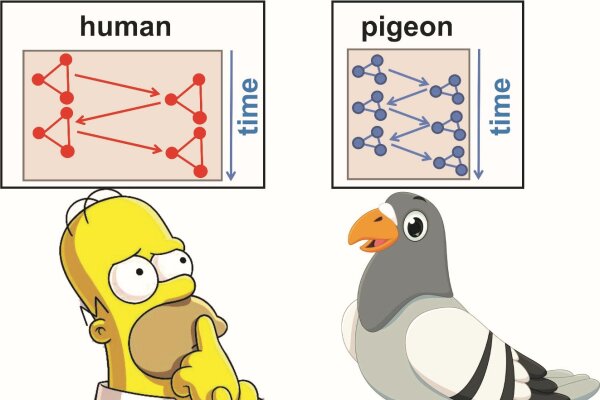2017-09-25

Birds have no cortex and mostly have small brains. How then is it possible that they can master so many complex cognitive tasks? It is known that birds have much more neurons than expected. Therefore, the avian pallium (mostly corresponding to the cortex) is characterized by small, extremely tightly packed neurons. It is conceivable that signal processing could be faster in such a brain as a result of a higher speed of propagation of activation between neighboring assemblies, resulting in faster switch times between neighboring neuronal representations of behavioral goals. Biopsychologists from Bochum and Dresden tested this idea and now indeed report that pigeons are on par with humans when a multitasking experiment demands simultaneous processing resources. However, when task conditions are slightly altered such that high speed of switching between pallial/cortical assemblies is required, pigeons show faster responses than humans. The scientists proposed that this superiority of pigeons could be a consequence of their miniaturized pallium with its high neuronal densities. Inter-neuron distances are on average 1.82 times smaller in pigeons compared to humans, possibly enabling fast activation propagation between neighboring assemblies. This then could represent a key advantage of the non-cortical avian telencephalon over a cortical forebrain.

Birds have no cortex and mostly have small brains. How then is it possible that they can master so many complex cognitive tasks? It is known that birds have much more neurons than expected. Therefore, the avian pallium (mostly corresponding to the cortex) is characterized by small, extremely tightly packed neurons. It is conceivable that signal processing could be faster in such a brain as a result of a higher speed of propagation of activation between neighboring assemblies, resulting in faster switch times between neighboring neuronal representations of behavioral goals. Biopsychologists from Bochum and Dresden tested this idea and now indeed report that pigeons are on par with humans when a multitasking experiment demands simultaneous processing resources. However, when task conditions are slightly altered such that high speed of switching between pallial/cortical assemblies is required, pigeons show faster responses than humans. The scientists proposed that this superiority of pigeons could be a consequence of their miniaturized pallium with its high neuronal densities. Inter-neuron distances are on average 1.82 times smaller in pigeons compared to humans, possibly enabling fast activation propagation between neighboring assemblies. This then could represent a key advantage of the non-cortical avian telencephalon over a cortical forebrain.